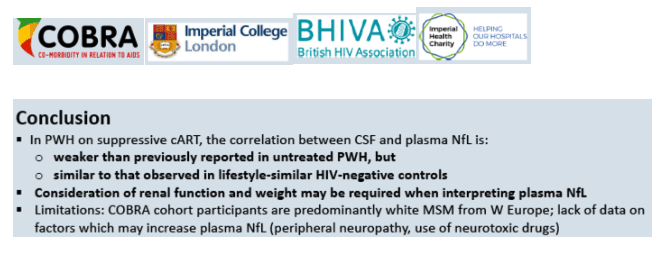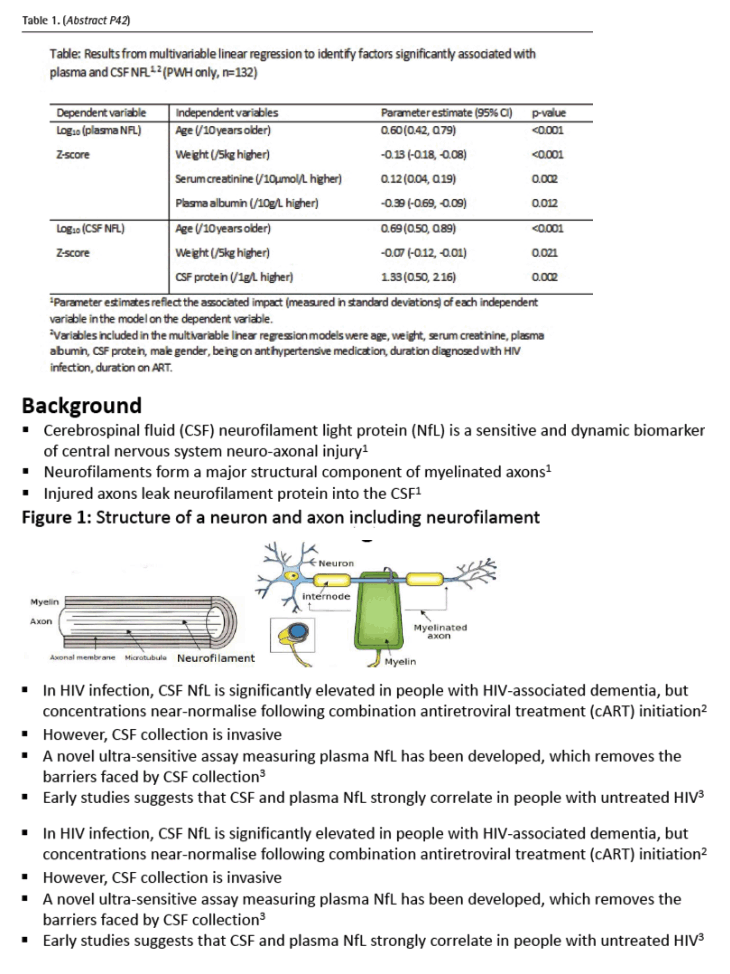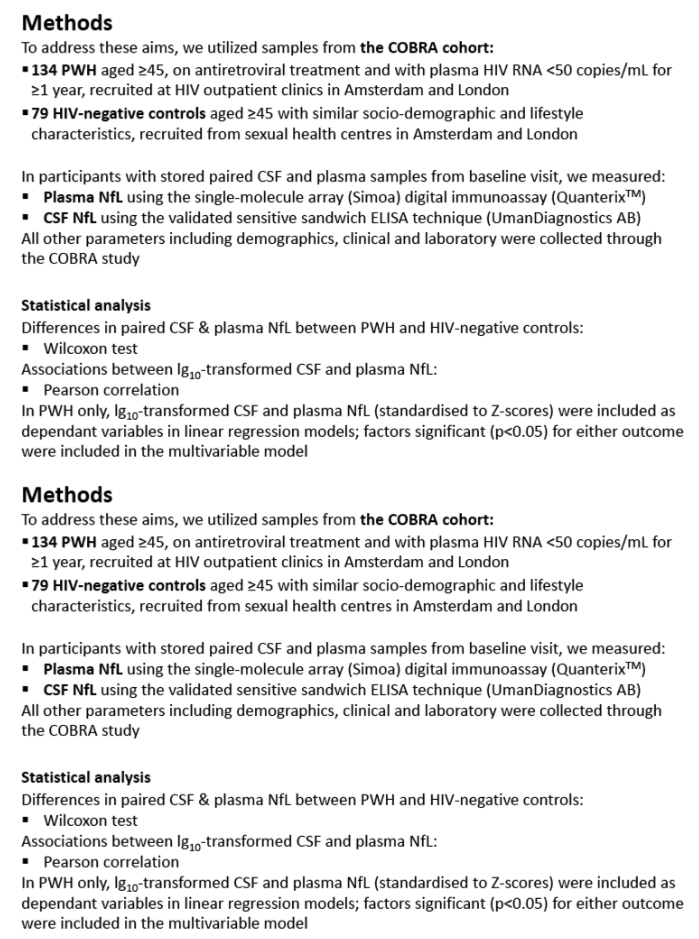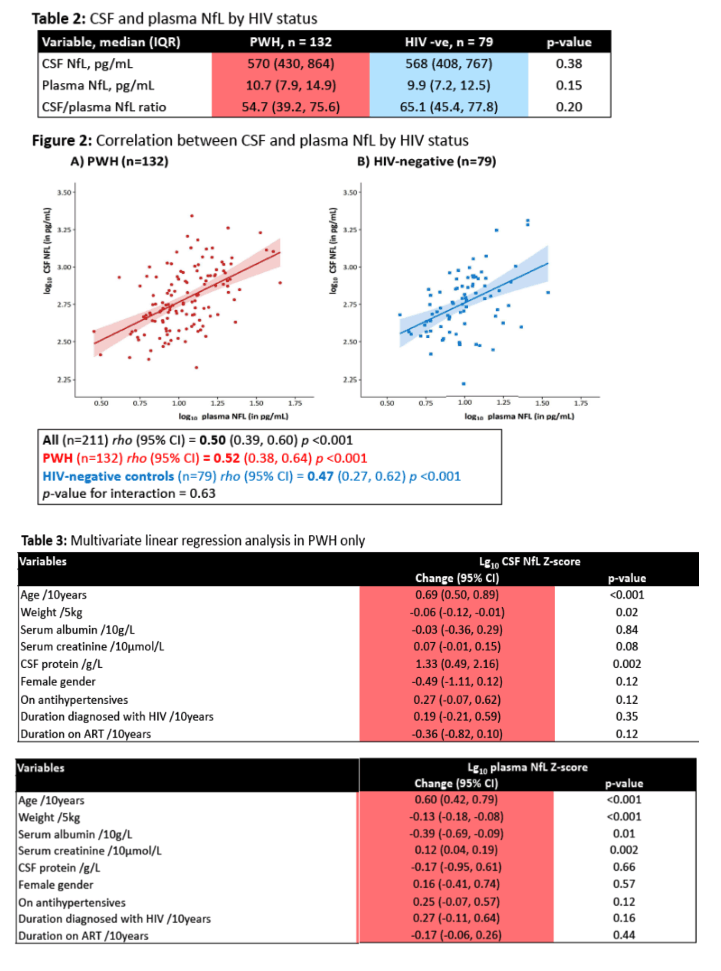 |
 |
 |
| |
Correlation between cerebrospinal fluid and
plasma NfL in treated HIV infection in the COBRA study
|
| |
| |
21st International Workshop n Co-morbidities and Adverse Drug Reactions in HIV
Nov 5-6 2019 Basel
J. Alagaratnam1,2, D. De Francesco3, H. Zetterberg3,4,5, A. Heslegrave3, J. Toombs3, N. Kootstra6, J. Underwood1,7,8, M. Gisslen4,5, P. Reiss6,9,10, C.A. Sabin3and A. Winston1,2on behalf of the COmorBidityin Relation to AIDS (COBRA) collaboration
1Imperial College London, UK 2Imperial College Healthcare NHS Trust, London, UK 3UCL, UK 4University of Gothenburg, Sweden 5Sahlgrenska University Hospital, Sweden 6University of Amsterdam, Netherlands7Cardiff University, UK8Cardiff and Vale University Health Board, UK9Amsterdam Institute for Global Health and Development, Netherlands10Stichting HIV Monitoring, Amsterdam, Netherlands

program abstract
Correlation between cerebrospinal fluid (CSF) and plasma concentrations of neurofilament light protein (NFL) in treated HIV infection in the COmorBidity in Relation to AIDS (COBRA) Study
J Alagaratnam1,2, D De Francesco3, H Zetterberg4,5,6,7, A Heslegrave8, J Toombs8, N Kootstra9, J Underwood1,10,11, M Gisslén12,13, P Reiss14,15,16, C Sabin3, A Winston1,2, the COmorBidity in Relation to AIDS (COBRA) collaboration
Purpose: CSF NFL is an established biomarker of central nervous system neuro-axonal injury. A novel ultra-sensitive assay can determine plasma NFL. In untreated people with HIV (PWH), plasma and CSF NFL are strongly correlated. We assessed this correlation in antiretroviral therapy (ART)-treated PWH and lifestyle-similar HIV-negative controls, and determined factors associated with plasma and CSF NFL in PWH.
Methods: Differences in paired plasma (Simoa digital immunoassay, QuanterixTM) and CSF (sandwich ELISA, UmanDiagnostics AB) NFL between PWH and HIV-negative controls were tested for significance using Wilcoxon’s test; associations between the values (after log-transformation) were assessed using Pearson’s correlation. Log-transformed plasma and CSF NFL, standardized to Z-scores, were included as dependent variables in linear regression models to identify factors independently associated with values in PWH; factors significant (P<0.05) in univariable analyses for either
outcome were included in the multivariable models.
Results: We included 132 PWH (median age 56 years, 94% male, 88% White, 100% HIV-1 RNA <50 copies/ml) and 79 HIV-negative controls (57 years, 92% male, 97% White). Neither CSF (570 versus 568 pg/ml; P=0.37) nor plasma (10.7 versus 9.9 pg/ml; P=0.15) NFL differed significantly between the two groups. Plasma and CSF NFL correlated moderately, with no significant difference by HIV status (PWH:
r=0.52 [95% CI 0.38, 0.63]; HIV-negative: r=0.47 [0.27, 0.62]; P [interaction]=0.63). In multivariable regression, older age and lower weight were each associated with higher plasma and CSF NFL Z-scores in PWH. Whereas lower plasma albumin and higher serum creatinine were associated with higher plasma NFL Z-scores, higher CSF protein was associated with higher CSF NFL Z-scores. See Table 1.
Conclusions: In PWH on suppressive ART, the correlation between CSF and plasma NFL is weaker than previously described in untreated PWH but similar to that observed in lifestyle-similar controls. Consideration of renal function and body composition may be required when utilizing plasma NFL.




|
| |
|
 |
 |
|
|